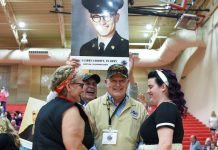The natural sunlight that streams from above at the front of First Christian Church’s sanctuary isn’t happenstance. Architect Eliel Saarinen designed the church’s sanctuary with natural light highlighting the cross at the front of the church more than 75 years ago.
Community stakeholders, preservationists and businesses have collaborated with the church — located at 531 Fifth St. in downtown Columbus — to keep the sanctuary light just the way Saarinen intended.
This week, Kenny Glass of Columbus is putting finishing touches on a new gable skylight on the roof of the church, designed to cover and preserve the panels of glass blocks original to the church’s lighting design in the sanctuary.
Come Sunday, parishioners will be able to look upward without worrying about potential rain leaks from the former barrel-type skylight structure which covered the blocks, added an estimated 50 years ago.
[sc:text-divider text-divider-title=”Story continues below gallery” ]Click here to purchase photos from this gallery
“People in the congregation are going to be very pleased we kept the original design,” said Steve Wiggins, one of the First Christian leaders who worked on the skylight project.
While completion of the skylight will be announced to the congregation Sunday, no ceremonies or ribbon cuttings are planned. That’s because there is still more restoration work to do.
Charting its path
The Friends of First Christian Church Architecture Advisory Board and Landmark Columbus officials are elated that while the church could have spent less money by roofing over the skylight and glass blocks, it worked with the community to raise funds to save the natural lighting design.
The congregation had options for everything from eliminating the skylight and glass blocks completely, by roofing over them, something that would have cost $30,000 to $40,000, or the more expensive effort to restore.
But if First Christian had decided to remove the skylight and roof over the glass blocks, it would have fundamentally changed the experience inside the sanctuary that the building’s architect envisioned, said Richard McCoy, who leads Landmark Columbus, an organization dedicated to preserving and maintaining Columbus’ architectural treasures.
“It’s such an iconic building,” McCoy said. “It would be a terrifying idea to lose the defining characteristics of that building.”
Instead, the church and its congregation solved the preservation problem by asking for help, McCoy said.
“And we got them the help. That’s the whole reason we created Landmark Columbus — to bring back these significant buildings and preserve them for the future,” McCoy said.
First Christian became Columbus’ first example of Modern architecture when it was built in 1942. The building is on the National Register of Historic Places and has been a favorite on the city’s architectural tour.
Raising funds
By late 2017, a collaboration of groups including the church working with Landmark Columbus, the Heritage Fund — The Community Foundation of Bartholomew County and Indiana Landmarks had raised nearly $161,000 for the restoration work. The congregation members contributed $142,000 of that amount.
The Heritage Fund helped raise another $17,000 for the project from the general public, which also included a significant contribution from the Columbus Area Visitors Center.
Another major contributor is Kenny Glass, which is making a $25,000 donation to the project as it writes the invoice for the just-completed job. The amount represents the value of the glass the company installed in the new gable structure, said Dave Bush, who supervised the project for the company.
The old skylight over the glass blocks at the front of the sanctuary was designed to stop water leaks through the exposed glass blocks in the roof that began leaking almost from the beginning, Bush said.
The skylight has been rebuilt with 28 pieces of glass laminated for safety, and now covers an area 13 feet wide and 50 feet long on the building’s roof, covering the glass blocks. The glass blocks have also been cleaned as part of the project.
Collaborating with architect Louis Joyner, who is project designer for the First Christian preservation projects, Bush said the glass company was brought on board and ordered the skylight pieces a few months ago. The company finished the job in a couple of weeks.
Four employees worked daily on the project — and two more at times. All that remains is to finish up with some sealant, Bush said.
Scaffolding that gave workers access to the roof and surrounds the sanctuary front is coming down soon, he said.
Bush said the acrylic barrel-type skylight didn’t fit the design of the building or roof, and had long lost its ability to keep rain off the glass blocks. The old structure could also be seen at the roofline, something the new design avoids.
The gable skylight has a low slope, rising about 8 inches above the glass blocks, shedding water to the side. The covering is crafted with aluminum and glass.
“It should last for the next 50 years,” Bush said.
None of the Kenny Glass leadership team are members at First Christian, but the donation and the work on the building come from a respect for the architectural significance of the church, Bush said.
More to do
While the original design has been preserved, an electronic feature has been added to the windows to the east side of the sanctuary to allow it to be shaded as necessary during video productions. That installation is expected to begin in September with completion this fall, Wiggins said.
The total amount raised for the skylight project exceeded what was needed, so excess funds are being used for other elements of church preservation.
First Christian’s tower, a signature image of architecture in Columbus, is coming apart at the top, for example. Mortar and joints are separating as the structure retains water, Wiggins said.
An Indianapolis engineering company is being hired to look at the structure, and Joyner’s expertise in historical architectural preservation will be needed, Wiggins said. There will also be mechanical and construction engineering expertise needed for the project.
And as the scaffolding comes down for the skylight project, one of the most expensive aspects will be scaffolding needed on the inside and outside of the tower for work to begin there, Wiggins said.
The project itself will take months, “plus a lot of money,” Wiggins said. “But we won’t know how much until we get the study done.”
[sc:pullout-title pullout-title=”First Christian Church skylight project costs” ][sc:pullout-text-begin]
$160,908: Contract for the project
$142,000: Amount raised by First Christian Church congregation
$25,000: Donation from Kenny Glass, Columbus, which did the skylight work this summer
$17,000: Amount raised by the Heritage Fund — The Community Foundation of Bartholomew County, which includes a significant contribution from the Columbus Area Visitors Center.
$200,000: Estimated annual maintenance expenses at First Christian
$1 million-plus: Projected as the total cost of all needed repairs to First Christian Church, to be spread out over time.
[sc:pullout-text-end][sc:pullout-title pullout-title=”To learn more” ][sc:pullout-text-begin]
To learn more about the Friends of First Christian Church Architecture, visit landmarkcolumbus.org/ffcca
[sc:pullout-text-end][sc:pullout-title pullout-title=”About the church” ][sc:pullout-text-begin]
Built: 1942
Designed as: The first contemporary building in Columbus and one of the first churches in the United States to be built in a Modern architectural style.
Designed by: Finnish architect Eliel Saarinen
Building features: Glass-fronted main hall, with a tower and bridge section. Interior details such as light fixtures, screen and furniture were designed by Saarinen’s son Eero Saarinen (who would later design the North Christian Church in Columbus) and Charles Eames.
Honors: The building was designated a National Historic Landmark by the National Park Service in 2001.
[sc:pullout-text-end]




